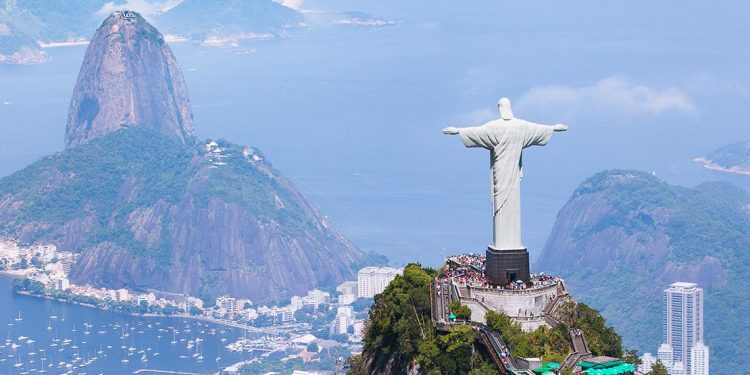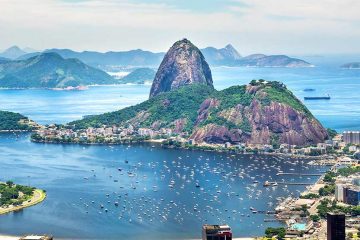
Immerse Yourself in This Vivid & Intoxicating City
Rio is alive. Dramas worthy of the silver screen unfold daily against a backdrop of improbably beautiful mountains and sea. Roars from football matches, the rich beat of samba and unrestrained laughter from people who know how to live life — these are the sounds that characterize this beguiling city.
Rio isn’t the kind of city you stop by on your way to somewhere else — it is the destination. There’s a reason why it’s such a booming locale for medical tourism — you simply can’t help but indulge in the myriad of attractions while you’re there.
You could easily spend weeks here, alternating between steamy rainforests and golden beaches by day, and hip-hop joints and street parties by night. No matter how you spend your time, you should make sure you tick off this essential list of things to do in Rio.
Cristo Redentor/Christ the Redeemer
Standing 125 feet tall and weighing in at 1,145 tons, Christ the Redeemer cuts an impressive figure. Mounted high on Corcovado mountain, the statue is visible from nearly every corner of the city. Unsurprisingly, the monument has become an icon and one of the greatest Rio de Janeiro attractions.
Built between 1922 and 1931, the statue initially represented Brazilian Christianity, but the wide open arms also reflect the welcoming nature of Brazilians.
Copacabana Beach
If you ever find yourself wondering what to do in Rio de Janeiro, you can always hit the beach. Copacabana is the most famous, located in the luxurious Zona Sul neighborhood. Along the edge of the powdery sands you’ll find plenty of places to score authentic Brazilian food, lavish hotels where you can splurge on a night or two of sea views and the mosaic-tiled Avenida Atlantica.
On the beach itself, throw down a towel and settle in for some people-watching. Spontaneous soccer games, bustling caipirinha kiosks and a mass of tanned bodies make this an entertaining place to spend the day.
These senior travel groups provide the opportunity for older travelers to see the world whether they're on a budget, going solo, or looking for adventure.
Parque Nacional de Tijuca/Tijuca National Park
The last remaining patch of rainforest that once surrounded Rio de Janeiro, the Tijuca is a wonderfully green escape from the city and an urban hiking novelty. An excellent network of trails will lead you between mountainous peaks, through wild jungle and to pretty creeks and waterfalls.
Keep an eye out for iguanas, monkeys and birds along the way. You can bring a packed lunch to enjoy at one of the lovely picnic spots within the park, or stop by one of the restaurants conveniently available.
Pao de Acucar/Sugarloaf Mountain
Pao de Acucar rises sharply up over the Rio Harbor. The monolithic shape is said to resemble a loaf of refined sugar, hence the name. Up on top, you’ll be 1,300 feet above the city with a spectacular panoramic view. This is the ultimate sunset spot in Rio.
Getting there is half the fun — you’ll need to hitch a ride on a glass-walled cable car dangling between Sugarloaf Mountain and Morro de Urca, another smaller peak. The ascent only takes a few minutes, but it’s a trip you won’t soon forget!
Escadaria Selaron
This might just be the most beautiful set of steps in the world, or at least the most photographed. Even if you don’t recognize the name, you’ll recognize the iconic yellow, green and blue tiled steps artfully decorated in the colors of the Brazilian flag.
The steps were created by Chilean artist Jorge Selaron, who renovated the once dilapidated steps as a tribute to the Brazilian people. There are 215 steps in total, covered in more than 2,000 tiles. Although initially Selaron scavenged tiles from construction sites for the projects, towards the end visitors donated tiles from all over the world.
Tiles from more than 60 countries are included in the steps.
From historical intrigue to outdoor adventure to culinary delights, there are a myriad of charming things to do in Charleston SC.
Rio Scenarium
What to do in Rio de Janeiro after dark? Visit Rio Scenarium, one of the city’s coolest nightclubs. Spread over multiple levels, here you can listen to live bands and marvel at samba dancers. The period building where the club is set is as interesting as the music and dance — nose around and you’ll discover an array of vintage stuff, from old barber chairs to ancient Chinese ceramics.
With all of the private rooms and hidden corners in Scenarium, plus a restaurant and all the drinks you need, you could easily lose yourself in here from dusk till dawn.
Confeitaria Colombo
Nibbling on pastries inside a century-old cafe sounds more like something you might do in Paris than Rio, but in Confeitaria Colombo you can do just that. Stop by for a leisurely afternoon of high tea or desserts, and to enjoy the elegant decor comprised of brocaded mirrors, stained-glass windows and marble counter-tops.
One of the best treats on offer is the pastel de nata, or custard tart, which gives you a little taste of lasting Portuguese influence in Brazil.
Churrascaria Palace
Serving up juicy cuts of beef since 1951, the Churrascaria Palace is delightfully old-fashioned. Stepping inside is like rewinding time. Rio’s most traditional steakhouse, the waiters are dressed in black and white and slice up the massive cuts of meat they bring right to your table with ease.
A word of warning: they’ll keep bringing meat to your table until you can’t eat another bite, so you should definitely bring your appetite along! This epic meat feast is an experience not to be missed when in Rio.
Asia travel is rich and varied, meaning your experience will be different everywhere you go, but will always be enlightening.
Favela Tour
Rio’s favelas are infamous. There are 800 favelas in the city and they are characterized by violence and lawlessness. Once dominated by drug lords and gangs, the favelas are slowly developing and becoming safer.
A favela tour is a fantastic way to get a glimpse into life in these shanty towns. Just approach the experience with sensitivity and a desire to learn. The socio-economic differences between the favelas and the wealthier areas of Rio are stark, so this is not your typical tourist experience.
